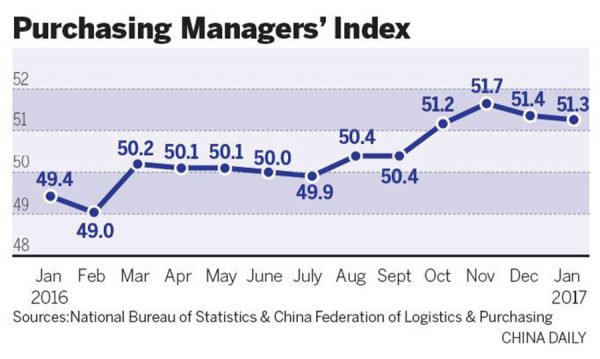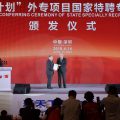
With many industrial segments recovering, the Year of the Rooster promises to help the real economy shake off recent troubles and crow again
Economy-trackers are highlighting facts and figures to indicate that the Chinese economy is entering 2017 on a strong footing, eclipsing last year’s tepid data that roiled financial markets.
For instance, the Purchasing Managers’ Index or PMI jumped to a more than two-year high of 51.7 in November, beating economists’ expectations, while a measure of non-manufacturing sectors of construction and consumer services hit its highest mark since mid-2014.
More glad tidings are coming from the energy industry, especially its renewable power segment, innovation, pharmaceuticals, overseas mergers and acquisitions, and measures like supply-side reforms (to reduce excess industrial capacity and shed unviable assets) and the Belt and Road Initiative.
To prevent money from pouring into speculative bubbles like equities and property, Beijing has prioritized the real economy as a major drive for sustainable and healthy economic growth, according to the Central Economic Conference in December that set the tone for economic development in 2017.
These are now seen as positives that could well outweigh concerns like capital outflows, a depreciating currency and rising labor costs.
Agreed Gao Qiang, general manger of Shanghai Ruijia Industry Co Ltd, an electric tools maker. He expects the New Year to be decisive for the company and the Chinese economy.
Ruijia began destocking its alternative current or AC-powered gardening tools, which represented 90 percent of its inventory, late last year. Instead, it began focusing on new-energy technologies. The efforts are beginning to pay off.
“Customers from the US and Europe flocked to the company’s booth, steering clear of AC-powered tools and checking prices of tools adopting new-energy technologies,” said Gao upon his return from the China Import and Export Fair in Guangzhou, Guangdong province, in November, the country’s largest trade event.
The government’s call for industrial upgradation has propelled Ruijia, a 50 million yuan ($7.2 million) business in rural Shanghai, to embrace renewable energy. Gao is targeting to have two-thirds of the company’s tools portfolio powered by lithium batteries in two years, compared to a mere 10 percent by the end of 2016.
“The year 2016 was the nadir for many manufacturers like us. With constant innovation and upscaling, we are already seeing signs of recovery,” Gao said.
Ruijia, he said, has already secured three orders from Spain for delivery this year.
Such signs of recovery are emerging across the $10 trillion-plus economy, which is bouncing back from last year’s sagging export manufacturing that created a drag on growth, experts said.
For instance, hectic deals activity at PowerArk Group, a photovoltaic firm, kept founder and chief executive officer Brendan Li awake even late at night in the run-up to the Spring Festival.
PowerArk inked major deals with Chinese and Dutch buyers in January. The firm first established its business in Australia in 2011, and made its name as one of the largest authorized solar panel distributors and wholesalers Down Under.
Two years ago, Li expanded the business to the mainland as renewable energy was becoming the preferred alternative to polluting coal-based power.
“No other market can rival China in terms of starting a new business, turning it profitable and at the same time contributes to social progress,” said Li, who is now overseeing the firm’s ambitious plan to list in the next three years.
The explosive growth in energy demand has inspired China to develop clean energy while optimizing its energy mix, Li said. The PV industry has greater potential as solar energy is easier to access than other new energy sources like wind, biomass and nuclear, she said.
China is expected to continue to be the world’s fastest growing solar PV market during the five years through 2020, according to the National Energy Administration.
Its ambitious push for renewables is supported by a host of policies and regulations such as the “PV Pioneer” program that encourage energy efficiency and domestic renewable energy deployment, which Li regards as favorable to PowerArk’s business expansion.
“Thanks to government policies and the ongoing education of the market, time is ripe for China’s PV industry to take off,” said Li, who remains bullish that the 500 million yuan business would reach a broader customer base in three years.
Perhaps, China’s power industry and related segments exemplify the current sense of optimism more than others.
Qi Yifu, president of Delixi-Electric Ltd, a low-voltage electric products and solutions provider, knows how cutting-edge technologies can be more than just cash cows.
The Anhui-headquartered company, together with parent Delixi Group, has provided over 160 patented technologies for the Shenzhou V and Shenzhou VI spacecraft launch projects.
Switch gears, circuit-breakers and transformers manufactured by Delixi were widely applied in the launch process, radars, missiles and tracking systems of the historic project.
“The implementation of supply-side structural reform creates a favorable macro climate for the whole low-voltage electric industry,” said Qi, whose company exports to over 50 countries.
“The deepening of reforms and the government’s support for innovation are encouraging the company to upgrade itself to achieve higher efficiency through automation, digitalization and smart manufacturing.”
To outperform its peers, Delixi has established its first authorized retail network and an e-service platform to offer customers a one-stop shopping experience. It is also leveraging big data analysis, a rarity in the low-voltage electricity industry across the world.
Such openness to adopting new ways, processes, mindsets and technologies marks Chinese businesses wishing to accomplish the daunting task of going global.
For instance, Luye Pharma, which started out as a maker of traditional Chinese medicine, is now betting on new formulations of drugs for neurological and psychiatric disorders, and international partnerships, to attain its goal of becoming one of the world’s top 100 pharmaceutical firms by 2020.
In the world’s most populous country with a growing aging population, Luye is not content with being just a supplier in the field of new drugs development, said Jiang Hua, its vice-president. Innovation in formulations, especially in long-lasting and suspended release preparations, is the path Luye is taking, he said.
Luye Pharma sees the current backdrop of global economic uncertainty as a great opportunity for overseas buyouts. The firm’s latest acquisition effort in Europe has helped it hedge risks as businesses expand beyond borders.
“We are optimistic about 2017. We aim to acquire or invest in American pharma companies with extensive local networks,” Jiang said.
The company is listed in Hong Kong, which gives it strong fund-raising capabilities and various financing opportunities.
Apart from optimism, businesses owners said they also face headwinds. As the yuan depreciated about 6.6 percent last year against the greenback. Fluctuating exchange rate is also a common headache for both Ruijia and PowerArk as they place procurement orders in the future.
“You will need to make a farsighted decision between signing long-term and short-term contracts,” Gao of Ruijia said.


